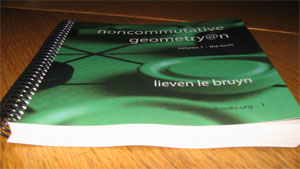
A quick reply to some of the comments
to the lulu/neverendingbooks post.
_Are they also
responsible for the graphical design in your books ?_ No! In fact it
was one of the more pleasant experiences of the last couple of weeks to
develop our own format, LaTeX-style and covers. The usual gang had their
say in all of this but it is only fair to say that Jan did most of the work. We developed
the cover-concept (that is, macro shots of games in duotones and placing
of titles etc) by trial and error. Jan is responsible for the
photo-shoot, I did choose the shots to be used and did the initial
coloring and placing of titles and left the final tweaking to Jan, who
did some lay-out work before. We, at least, are happy with the
result… As mentioned before, the LaTeX-style sheets were made
using the
memoir package.
_Who is responsible for trying to sell
the book, you or them?_ I dont think we are doing great efforts to
try to sell the books, yet. Up to now, you can only get to the
book-sites via this blog or via my homepage. Lulu claims that they will only make
money if we do… and as this is clearly sales-talk (they make money
on every book they print) it involves no (or a very small) financial
risk on our part. Anyone who wants to have a copy of one of our books,
orders them at Lulu, they print it and ship it to you. But beware! They
have several shipping options and for most of them it costs you more to
get them shipped than to buy the books… In fact, that was the main
reason why we didnt put the URL online before we had two volumes out.
The reason being that if you buy for over 25dollars you can have them
shipped via their “SuperSaver” option, that is, shipping is free (but
probably slow). But, based on my own experience it works well (I ordered
a few copies of book 1 via SuperSaver and another one via their
InternationalShipment and got the free SuperSaver package a day before
the costly other shipment…). Our real investment is that we have
bought ISBN-numbers for the books (at a price of 35dollars/book) and
hope to earn this back from a small royalty we get from each book (the
Lulu-rule is that they get 25% of any royalties you set). Even though we
are not entirely happy with the distribution process we opted for this
series for an unusual book-format making it handy and fun to use (the
square 7.5 x 7.5 inch format is very pleasing to read and the
coil-binding makes it extremely handy to lay flat on the table). So we
view this series as a student-edition of the books and we keep them as
cheap as possible. At a later stage it may happen that we will also have
a library-edition of the books which will have global distribution
(meaning that you can order them via Amazon or your local bookshop). For
this to work, you have not so much freedom in your book-format and can
only have regular binding. Besides, buying such a global-ISBN is more
costly and will make this edition (a lot) more expensive. But, as you
can see from the picture, the books get printed and shipped and look
VERY nice. In fact, of the few copies I ordered, I had to hand out
already two because some people just liked the feel and touch of it. I
think, people will only gradually be willing to buy their own copy when
(1) they have glanced through a copy at some meeting or seminar and (2)
if more volumes come out and they have a greater choice in bying 2
volumes to get free shipping. On this last issue : already three people
have expressed interest in writing a book in our series. My own hunch is
that the next book out will have to do with Poisson noncommutative
geometry and will have a macro shot of a war-game on its cover (authors
can give suggestions for which games they want on their cover), curious
how this will work out…
_How many have you sold so
far?_ Well, not enough so far to get our ISBN-investment back…
But, once again, I think it will take some time for people to trust the
series enough to buy a volume or two. In the first week we made the URL
available we sold 16 books, so if you want to increase our sales-index
please do by going to this
page for the first volume and to this page for the second
volume. But perhaps it is easier to bookmark the lulu/neverendingbooks if
you want the latest news on the series. I”ll keep you posted on our
sales via this page. If you buy a book and like the result, please tell
others about it (or even better, let them see and feel the copy.
Hopefully you will get it back…)


